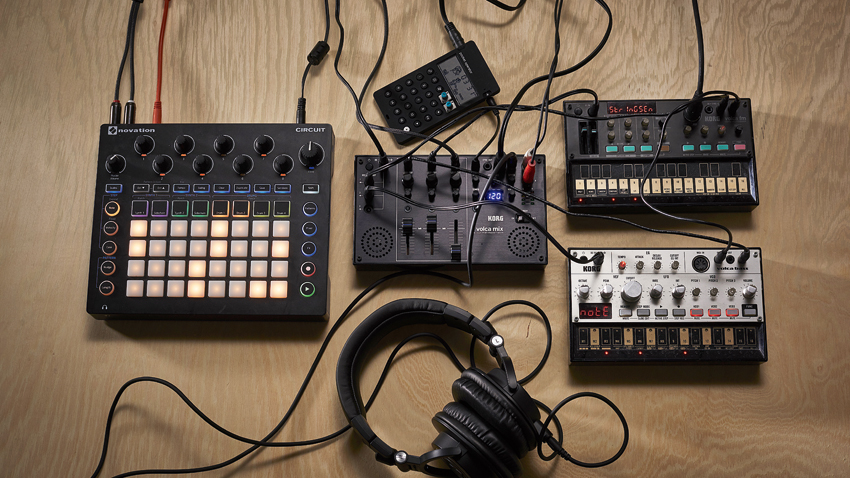Ditch the laptop: How to make music with a budget all-hardware setup
You don’t need to splash out thousands of pounds to create an all-hardware setup. Here’s a simple and affordable laptop-free rig

The rise in wallet-friendly hardware in recent years has made it more affordable than ever to get out of the box and take a more hands-on approach to production.
For the centrepiece of this sub-£600 setup, we’re using Korg’s new Volca Mix, which allows us to sum two mono channels and one stereo channel to a master out. The Volca Mix is a little on the rough and ready side, but the sound quality is good and it has a Send/Return for adding extra effects, plus it has a pumping compressor and stereo widener.
Novation’s original Circuit groove box is a handy tool for economic hardware music making; it has four sample channels and two four-voice digital synths, so we can get a lot of track elements out of it. Here, we’re using the sample channels for our beats. Per-step sample switching allows us to get more than four sounds out of these channels - we use a single channel for open and closed hi-hat sounds, and another for multiple tom and percussion sounds. Recording automation of pitch, decay and filter parameters using the Macro knobs brings variety.
Circuit’s pattern sequencer lets us input and chain eight 16-step sequences for each channel, so there’s plenty of scope for creating longer compositions. There are reverb and delay sends onboard, too, which can help bring a bit of extra life to the sounds. The digital synth engines are great for thick chords and moving pads, thanks to their easy-to-tweak Macro controls and well-crafted modulation.
Circuit training
In this setup, we’re partnering the Circuit’s digital synth engine with two instruments from Korg’s Volca range. The Volca FM adds a retro-tinged frequency modulation synth engine with built-in chorus and arpeggiator, that’s great for lead lines and bell-like sequences. The Volca Bass, meanwhile, is a three-oscillator analogue synth that compliments our other digital instruments by bringing some raw low-end grit.
For sync, we’re using the Circuit as our master clock. We’ve connected the Circuit’s MIDI out to the Volca FM’s MIDI In. Circuit sends out both MIDI clock and note data (Synth 1’s sequencer outputs on MIDI channel 1, Synth 2’s on channel 2). In Circuit’s Settings menu - accessed by holding Shift on start-up - we can turn MIDI clock and notes on and off, should we wish to only send one or the other to the FM. In this setup, however, we’re using both.
We’ll program a chord pattern on the Circuit’s first synth, and pair this with an arpeggiated version of the same chords coming from the Volca FM. We’ll then use pulse sync to link the two Volcas. We’ve linked the FM’s Sync Out to the Bass’s Sync In, so that the latter will match the tempo of the former. We’re then programming the Volca Bass via its onboard sequencer. (Tip: the Volca Bass is actually paraphonic, so we can program different bass patterns for each of its oscillators. Try this for a trio of bass riffs fed through the same filter/amp).
Get the MusicRadar Newsletter
Want all the hottest music and gear news, reviews, deals, features and more, direct to your inbox? Sign up here.
The Circuit has an inbuilt mixer for balancing its synths and samples, and a global filter, which we can use for performance sweeps. The Volca Mix also has filters for each channel, which can help in shaping the EQ. The Send on the Mix gives us the option to add an additional effect (or a chain of them), to enhance our sounds. A reverb or delay pedal would be the obvious choice here. For something a little bit more on the esoteric side, we’re using Teenage Engineering’s PO Speak. This is a sampler and vocoder that allows us to sample short chunks of audio from our other instruments, or process them on the fly through its multiple varieties of vocal synth.
Finally, it’s very much worth bearing in mind that you will need to amplify the output from the Volca mix before it goes into any speakers.
The pros and cons
The main upside to a compact setup like this is obviously affordability. We’ve essentially got a fully-featured, decent quality performance rig without having to approach the £1000 barrier. There’s a decent degree of flexibility, too, through loading different styles and textures of sample into the Circuit and exploring different synth presets. (Tip: the Volca FM can load DX7 patches, of which there are loads available online.) For something more beat-focussed, try swapping out the Volca Bass for the excellent Volca Kick, or the FM for the Volca Sample, giving more sample playback tracks to play with.
On the downside, this setup is pretty lo-fi. It’s good for rough-edged dance music - particularly once we push the Volca mix compressor to get things pumping. You’ll struggle to create more ‘pristine’ genres like pop or R&B, but if raw, analogue sound with hands-on manipulation are what you’re after though, look no further.
For more laptop-free music production and performance action, get your hands on the August 2018 edition of Future Music.
Future Music is the number one magazine for today's producers. Packed with technique and technology we'll help you make great new music. All-access artist interviews, in-depth gear reviews, essential production tutorials and much more. Every marvellous monthly edition features reliable reviews of the latest and greatest hardware and software technology and techniques, unparalleled advice, in-depth interviews, sensational free samples and so much more to improve the experience and outcome of your music-making.










